


Established in the spring of 2005 by Zelalem Merawi, at the time already a well-known figure in the tourism and car rental sector of our Country, Zelalem Tour and Car Rental, with registered office in Addis Ababa, Ethiopia, brings together quality with loyalty in rendering a professional service for both local and International customers. Since its establishment, in the course of a decade, Zelalem Tours has made a name for itself as a brand signifying quality and reliability, a benchmark for people wishing to travel in full freedom and at the same time be able to rely on constant and discreet assistance. Operating successfully in the medium-high end of the market, Zelalem Tours and Car Rental has won the trust of an exclusive and highly demanding customer base.
 Our Multiple International awards are witness of our outstanding service. At Zelalem tour and car rental every adventure is private, flexible and customized to your exact needs, Start and ends your vacation whenever you want and make any itinerary changes you need. With our brand new vehicles, either with a skilled driver or without, our car rental service gives you the freedom to experience even the remote corners of the world in a completely refreshing way.
Our Multiple International awards are witness of our outstanding service. At Zelalem tour and car rental every adventure is private, flexible and customized to your exact needs, Start and ends your vacation whenever you want and make any itinerary changes you need. With our brand new vehicles, either with a skilled driver or without, our car rental service gives you the freedom to experience even the remote corners of the world in a completely refreshing way.
Our insightful tour package trips and variety of car rental services are not the only service we offer to our customers, we also facilitate ticket bookings, hotel bookings, boat and other adventures animal riding arrangements.
+ Most world heritage sites ;( UNESCO) in Africa
+ Great customer service + Well organized + Professional staff members + Safety focused + Free travel advice + Affordable tour package + Small to large groups + Half day to long range tours
+Rich history, Variety of culture, Spectacular nature,800 species of birds, Wildlife…all in super affordable price.
Covering an area of 2200 km2 Bale Mountains National Park is the largest remaining alpine habitat on the African continent. Founded in 1970, the Park contains the biggest continuous area of Afro-alpine vegetation (~1000 km2, circa 17.5% of all Afro-alpine vegetation) and a large proportion of moist tropical forest.
Bale Mountains National Park offers opportunities for unsurpassed mountain walking, horse trekking, scenic driving and chances to view many of Ethiopia's endemic mammals, in particular Ethiopian Wolves, Simien Foxes, Menelik's Bushbucks and Mountain Nyalas.
Birds such as the Thick-billed Raven, Wattled Ibis, Blue-winged Goose, Rouget's Rail, etc. can easily be seen in the Park. Bale is the southern-most breeding population of Golden Eagles, Wattled Cranes and has a large breeding population of Bearded Vultures. The wetlands and forests of Bale are the source of major rivers which provide a significant proportion of the perennial water supply to approximately 10 million people in South-eastern Ethiopia and Somalia.
Including one of the principal mountain massifs of Africa, the Simien Mountains consist of several plateaus, separated by broad river valleys. With over twenty peaks towering to heights above 4000 meters, Simien escarpments are also known as the "Roof Of Africa". Its highest peak, Ras Dashen at 4543 meters, is the fourth highest peak on the African continent. The Simien escarpments, which remind of the Grand Canyon of the USA, have been adopted in 1978 by UNESCO as a World Heritage Site. The Park which covers 179 km2 lies at an altitude between 1900 and 4500 meters.
The mountains are lush and green: your former conception of Ethiopia is likely to be turned over. The park offers great possibilities for trekking, with dramatic and exhilarating scenery.
The dramatic landscape of the Simien Mountains is the result of massive seismic activity in the area about 40 million years ago. Molten lava poured out of the earth's core reaching a thickness of 3000 m. This massive eruption has created one of the most spectacular landscapes in the world, with jagged mountain peaks, deep valleys and sharp precipices dropping some 1,500 m. The famous pinnacles - the sharp spires that rise abruptly from the surrounding land - are volcanic necks: solidified lava and last remnant of ancient volcanoes.
Access to the park is from Debark; about 2 hours drive north of Gondar. Buyet Ras, Sankaber, Geech and Chenek are the four major campgrounds of the park
The beautiful landscapes and the peaceful environment are favorable conditions for mountain biking in Ethiopia. Zelalem Tours organizes a unique and truly rewarding biking holiday. Our cycling tour includes the spectacular ride either to Bale Mountains or to the Rift Valley region. It can also be arranged following the great historic route of Ethiopia.
Biking in Ethiopia is mostly along paved and gravel roads, crossing mountains and through undulating landscapes. Most of the time clients ride their bike, but there are also places where you are driven in the car in case of exhaustion, long distances or road conditions.
Taking the riding distances into consideration we arranged camping days on our biking trips. Our cook prepares delicious meals while camping. Join one of our biking tours and enjoy an Ethiopian outdoor experience
With more than 30 active and dormant volcanoes, the Danakil Depression is a geological marvel. In stark contrast to the cool, temperate Ethiopian highlands, it is one of the lowest, driest, and hottest places on earth. It boasts records including the hottest average annual temperature (48º C/118º F in the dry season) and lowest point (155m/509 ft below sea level) on the African continent. But don’t let this deter you from visiting Danakil as the trip is full of adventure and surely one you will never forget.
The Danakil truly is one of the most unique geological areas on earth. A strange and mysterious landscape - scattered with noxious hot springs, frozen black-lava flows, and massive salt basins left over from ancient lakes – it is one of the most tectonically active places on the planet. Erta Ale, the region’s most-visited and active volcano, has maintained a permanent lava lake (one of 5 on the earth) for the past 120 years! If you are looking for an almost extra-terrestrial experience, the Danakil Depression is the place to come.
The Afar inhabitants – a nomadic people – lead camel caravans for hundreds of kilometers across the unfriendly landscape. They cut salt blocks from the dried lakebeds and sell them in towns far away. Although in the past they have demonstrated inhospitality and unwelcome to outsiders, in recent years they have recognized the benefits that tourism can bring and have accepted foreigners. For the intrepid traveler, the Afar region will surely be an unforgettable adventure.
**A trip to the Afar region should only be undertaken with proper planning and a knowledgeable guide. With an average annual temperature of 34-35º C, abundant supplies of water should be taken along. With a knowledgeable guide, up-to-date information from embassies in Addis Ababa, and a well-planned trip, a safe tour can be taken to the region.
With new modern architecture and an ancient history, Addis Ababa offers a rich cosmopolitan atmosphere. Ethiopia has often been called the original home of mankind due to the various fossil discoveries in the northeastern Afar region, but more recently scientists claim the land of what is now the city of Addis Ababa as the cradle of mankind.
In the 1870's, Menilik II moved ever southwards until he reached the Entoto mountain, where he set up a milltary camp. Strategically it was a strong position, but after some years Menilik II decided he no longer had any need for such an exposed position.
He moved a few kilometers down the southern slopes of Entoto Mountain to establish the present Ethiopian capital, which his wife Empress Taytu named Addis Ababa (New Flower). It was formally established in 1886.
Addis Ababa is currently a major hub for many local and international organizations, including the African Union, the United Nations branch office, the United Nations Economic Commission for Africa (ECA), the Africa Hall, and more than eighty foreign embassies and consultants.
One can also visit Merkato (the biggest open air market in Africa), Mount Entoto, the National Museum (where Lucy's remains rest), and many statues and monuments.
The city has a flourishing cultural life with regular exhibitions, lectures and opportunities for music and dance. Ethiopia also offers the wonderful culinary delights of injera, a large pancake-like crepe that forms the base of most Ethiopian meals, and tej, the distinctive Ethiopian traditional honey wine.
At an altitude of 2,500 meters, Addis Ababa is the 3rd highest capital city in the world after Lapaz and Quito in Latin America.
The Famous Tribes of Omo Valley in Southwestern Ethiopia
Although relatively large, Arbore is far more rustic and unaffected than many similarly sized towns in South Omo. In common with their linguistically and culturally afflicted Tsemai neighbor, the Arbore migrated to their present homeland from Konso and the pastoralist of the surrounding lowland. The Arbore traditionally played an important role as a middleman in trade between the Omo River and the Konso highland. The town of the Arbore lies in an area covering several tribal boundaries. And because the Arbore people routinely intermarry with other ethnic groups, the tribe is also inhabited by a substantial number of Hamer and even Borena women, adding a cosmopolitan feel to the worthwhile Saturday market.
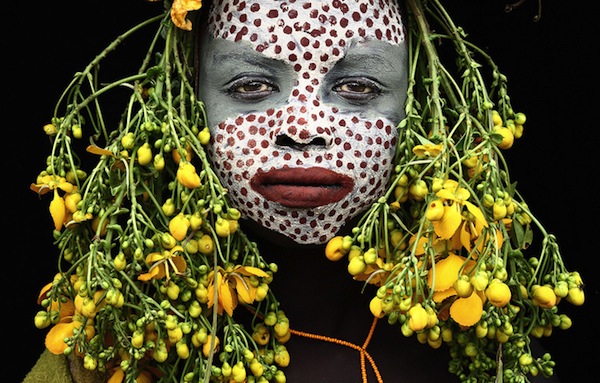 The Mursi live between their dry & wet season range on the Tama plains, north of Mago park in the Omo River region of southwestern Ethiopia. They care for livestock and plant some crops. The men practice light scarification on their shoulder after killing an enemy and shave geometric patterns on their head. During dance and ceremonies they adorn literally every part of their body with white chalk paint. Young unmarried men practice group stick fighting. The winner is carried on top of poles to girls waiting beside the arena, who decide among themselves which of them will ask his hand in marriage.
The Mursi live between their dry & wet season range on the Tama plains, north of Mago park in the Omo River region of southwestern Ethiopia. They care for livestock and plant some crops. The men practice light scarification on their shoulder after killing an enemy and shave geometric patterns on their head. During dance and ceremonies they adorn literally every part of their body with white chalk paint. Young unmarried men practice group stick fighting. The winner is carried on top of poles to girls waiting beside the arena, who decide among themselves which of them will ask his hand in marriage.
The Karo, which number only about 3,000 people, mainly live on the practice of flood retreat cultivation on the bank of the Omo River in southwestern Ethiopia. The Karo excel in face and body painting, practiced in preparation for their dances and ceremonies. They decorate their bodies, often imitating the spotted plumage of a guinea fowl. Feather plumes are inserted in there clay hair buns to complete the look.
The clay hair buns can take up to three days to construct and is usually re-made every three to six months. Their painted facemasks are spectacular. Karo women scarify their chest to beautify themselves. Scars are cut with a knife and ash is rubbed to produce a raised welt. Being the smallest tribe of the area, this group obviously struggles with direct threats from nearby tribes that have more gun power, greater number, and likely coalitions with one another.
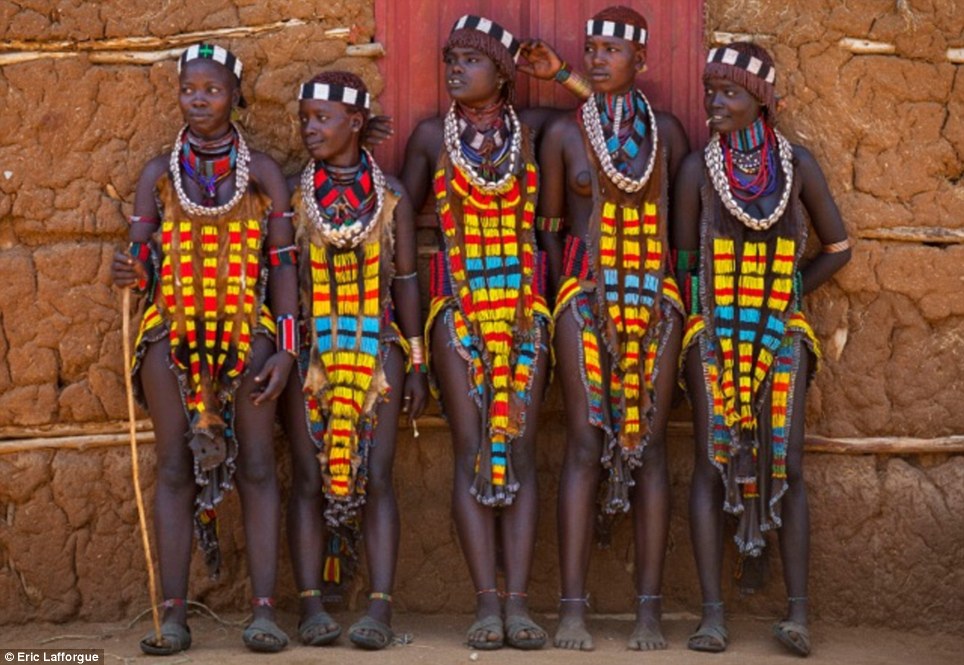 The Hamers are pastoralists and number 30,000 people. They are known for their practices of body adornment and wearing a multitude of colorful beads. Women adorn their necks with heavy polished iron jewelry. Hamer society consists of a complex system of age groups. Moving from one age group to another involves complicated rituals. The most significant ceremony for young men is the "jumping of the bull" - the final test before passing in to the adulthood. Several days before the ceremony, the initiate passes out invitations in the form of dried knotted grass. The ceremony lasts three days. Late in the afternoon on the final day, ten to thirty bulls back and then run across the line of animals. At the end of the line, he turns back to repeat the performance in the opposite direction. He must make this unstable journey without falling. The Hamer men have a reputation of being less than adoring husbands. The women submit to the ritual flogging proudly and love to show the deep scars that are regarded as proof of devotion to their husbands.
The Hamers are pastoralists and number 30,000 people. They are known for their practices of body adornment and wearing a multitude of colorful beads. Women adorn their necks with heavy polished iron jewelry. Hamer society consists of a complex system of age groups. Moving from one age group to another involves complicated rituals. The most significant ceremony for young men is the "jumping of the bull" - the final test before passing in to the adulthood. Several days before the ceremony, the initiate passes out invitations in the form of dried knotted grass. The ceremony lasts three days. Late in the afternoon on the final day, ten to thirty bulls back and then run across the line of animals. At the end of the line, he turns back to repeat the performance in the opposite direction. He must make this unstable journey without falling. The Hamer men have a reputation of being less than adoring husbands. The women submit to the ritual flogging proudly and love to show the deep scars that are regarded as proof of devotion to their husbands.
Also known as Nyangatom or the Bume, the Bumi live south of Omo National Park and occasionally migrate in to the lower regions of the park when water or grazing is scarce. Numbering around 6,000-7,000 in population, the Bumi are agro-pastoralists, relying on cattle herding and floor-retreat agriculture (consisting mainly of sorghum harvesting on the Omo and Kibish River). The Bumi tend to indulge in honey and frequently smoke out beehives in the park to get the honey inside the nest. The Bumi are known to be great warriors and quite frequently, active warmongers. They are often at war with the neighboring tribes including The Hamer, The Karo and The Surma tribes. A small group of Bumi living along the Omo River are specialized crocodile hunters who use harpoons from a dugout canoe. The elders of both sexes wear a lower lip plug. The men's is made from ivory and women's is made from copper filigree.
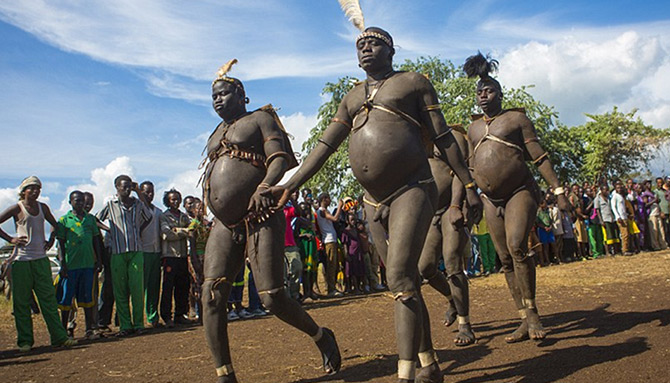 The Bodi are pastoralists living close the Omo River in southwestern Ethiopia. The Bodi are of Nile-Sahara stock and pastoral background. Although they do cultivate sorghum along the banks of the Omo River, their culture is very much cattle- centered. Similar to the Mursi, livestock plays an important role in marriage, divination, and name giving rituals. The Bodi classification of cattle is complex, with over eight words to denote different color and patterns. Bodi dress is simple. The women wear goatskins tied at the waist and shoulder, while men fasten a strip of cotton or bark-cloth around their waist.
The Bodi are pastoralists living close the Omo River in southwestern Ethiopia. The Bodi are of Nile-Sahara stock and pastoral background. Although they do cultivate sorghum along the banks of the Omo River, their culture is very much cattle- centered. Similar to the Mursi, livestock plays an important role in marriage, divination, and name giving rituals. The Bodi classification of cattle is complex, with over eight words to denote different color and patterns. Bodi dress is simple. The women wear goatskins tied at the waist and shoulder, while men fasten a strip of cotton or bark-cloth around their waist.
Ari women are famous for their pottery which they sell to support their families. The Ari people inhabit the northern border of Mago National Park in southwestern Ethiopia. Ari villages have neat compounds in fertile and scenic land with coffee plantations. They have large livestock herds and produce large quantities of honey. The women wear skirts from the banana-like tree, called Enset.
Aside from dramatic view back to Rift Valley lakes near Arba Minch, ChenCha is of interest to the traveler as the home of the Dorze people. These people are renowned cotton weavers whose tall beehive-shaped dwelling are among the most distinctive traditional structures to be seen anywhere in Africa. The Dorze speak an Omotic tongue, similar to the languages of the lower Omo Valley. It is, above all, the unique Dorze houses that make ChenCha worth a diversion. These remarkable extended domes measure up to 6m tall (roughly the height of a two-story building), and are constructed entirely from organic material.
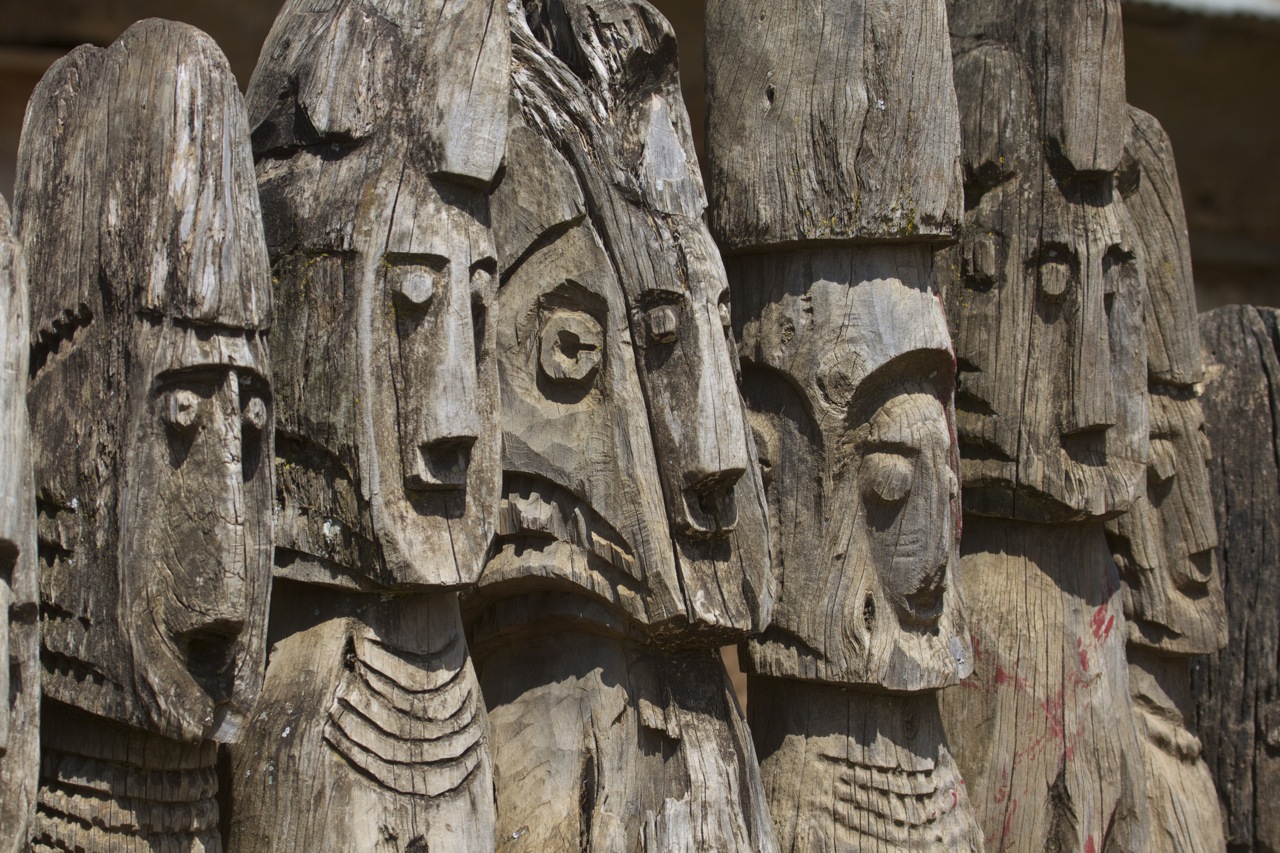 The Konso inhabit an isolated region of basalt hills (essentially an extension of the southern highlands). Their land lies at an altitude range of roughly 1,500m to 2000m. They are flanked to the east by the semi-desert Borena Lowlands and to the west by the equally harsh lower Omo Valley. Mixed agriculturists, the Konso make the most of the hard, rocky slopes that characterize their relatively dry and infertile homeland through a combination of extensive rock terracing, the use of animal dung as fertilizer, crop rotation, and hard work. Traditionally, waga will be erected above the grave of any important Konso man or worriers, surrounded by smaller statues of his wife and defeated foes.
The Konso inhabit an isolated region of basalt hills (essentially an extension of the southern highlands). Their land lies at an altitude range of roughly 1,500m to 2000m. They are flanked to the east by the semi-desert Borena Lowlands and to the west by the equally harsh lower Omo Valley. Mixed agriculturists, the Konso make the most of the hard, rocky slopes that characterize their relatively dry and infertile homeland through a combination of extensive rock terracing, the use of animal dung as fertilizer, crop rotation, and hard work. Traditionally, waga will be erected above the grave of any important Konso man or worriers, surrounded by smaller statues of his wife and defeated foes.
The Dasanech, alternatively known as the Galeb or Reshiat, range across a large territory following the western banks of the Omo River to Lake Turkana. Local oral tradition, reinforced by that of the Turkana, recounts that the Dasanech migrated to their current homeland from a region called Nyupe, to the west of Turkana, after being forced out by the expansionist wars of the Turkana in the late 18th century. Like the Turkana, Samburu and Gabbar of northern Kenya, the Dasanesh/Galeb were originally pure pastoralists, living an almost totally nomadic lifestyle. The abundant water frontage and fertile soil of their present territory has subsequently pushed them toward a more diverse subsistence economy, based around fishing and agriculture as well as herding livestock.
Ethiopia is the land of natural contrasts from the top of the rugged Semien Mountain to the depth of the Denakil Depression which, at 20m below sea level, is one of the lowest dry land points on earth. The Great Rift Valley is a remarkable region of volcanic lakes, with their famous collection of bird-life, great escarpments and stunning views for visitors.
On top of diverse and abundant vegetation, many of Ethiopia's natural parks are mentioned as some of the last remaining untouched wilderness of Africa. With 13 major reserves, Ethiopia provides a microcosm of the entire Sub-Saharan ecosystem. Bird life and indigenous animals from the rare Walia Ibex to the shy Wild Ass roam freely just as nature intended. Ethiopia, after the rains, is a land decorated with flowers and with many more natural plants than most countries in Africa.
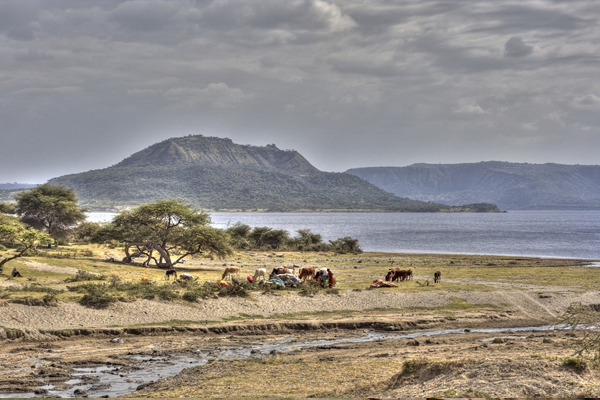 Covers an area of 2,470 square kilometer, contains Ethiopia's second highest peak, Mount Batu (4,304m). It is an area where one can either walk or drive, and is one of the best places to see the endemic Semien Red Fox, the Mountain Niyala and Menilik's Bushbuck. The park, with its branching mountain air, is ideal for hiking or climbing and horses are available for long or short rides in the mountains. The one and only road through the park gives motorists some breathtaking views.
Covers an area of 2,470 square kilometer, contains Ethiopia's second highest peak, Mount Batu (4,304m). It is an area where one can either walk or drive, and is one of the best places to see the endemic Semien Red Fox, the Mountain Niyala and Menilik's Bushbuck. The park, with its branching mountain air, is ideal for hiking or climbing and horses are available for long or short rides in the mountains. The one and only road through the park gives motorists some breathtaking views.
Not far from the Bale Mountains is one of the world's most spectacular and extensive underground caves: the Sof Omer cave system. Formed by the web river as it changed its course in the distant past and carved a new channel through limestone foothills, Sof Omar is an extraordinary natural phenomenon of breathtaking beauty.
The Semien Mountain massif is one of the major highlands of Africa rising to the highest point in Ethiopia, Ras Dejen(4620m). This is the fourth highest points where night temperatures often fall below zero.
The parks shelter the afro-alpine high mountains. Wildlife includes the Walia Ibex, Ethiopia wolf, Gelada baboon as well as klipspringer, augur buzzard; verreaux's eagle and falcon also soar above this mountain. The Semien escarpments are recorded by UNESCO (the world heritage site), and are often compared with the Grand Canyon in the USA.
Two different lakes in one park, the two lakes are both terminal lakes and their beaches are unstable, saline, and both different in character. Abiyata is shallow at about 14m with a fluctuation of water level. The steam mouth is the source of relatively fresh water, much frequented by water bird for drinking and bathing. The Lake is surrounded by gentle, grass covered slopes and acacia woodland.
By contrast, surrounded as it is by steep black cliffs and peaks that reflect in its water, is the deepest lake of the Rift Valley (260m). It is exceptionally beautiful, with shores that gives a scent of mystery with their hot sulfurous springs that bubble up and flow in to the lake.
There are over 400 bird species recorded here, almost half the number recorded for the whole country. Although the islands in Lake Shala are a real bird's paradise, the birds fly to Lake Abiyata to feed. Large numbers of flamingos gather here together with great white pelicans and a wide variety of other water birds.
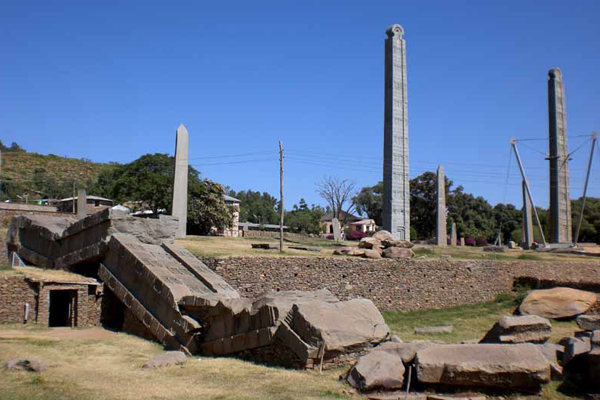 Some 365 kilo meters northeast of Gondar lies the town of Axum, Ethiopia’s oldest city. Axum dates back some 2,000 years to when it was the hub of the Axumite Empire. The Queen of Sheba made it her capital 1000 years before Christ. The Ethiopian Orthodox Church was founded here in the fourth century and Axum remains the holist city of the Ethiopian Orthodox Church.
Some 365 kilo meters northeast of Gondar lies the town of Axum, Ethiopia’s oldest city. Axum dates back some 2,000 years to when it was the hub of the Axumite Empire. The Queen of Sheba made it her capital 1000 years before Christ. The Ethiopian Orthodox Church was founded here in the fourth century and Axum remains the holist city of the Ethiopian Orthodox Church.
All that remains now of Axum’s past glories are the huge granite stelae (pillars), some fallen and some still perpendicular. Made of single blocks of granite, the tallest stood over 33 meters high-the largest monolith in the world. The biggest now standing is 23 meters high.
Today, the Arc, which once housed the Ten Commandments, remains well hidden in Axum. It is guarded by a select group of monks, whose sole commitment is to protect the sacred vessel. Axum is also known for its massive, towering sculptures that are thousand years old.
All three section of the 1,700 years old Axum obelisk has arrived back in Ethiopia, 68 years after it was looted by ltalian fascists. Many Ethiopians see the obelisk as an important national symbol-its return has been subject to great national anticipation and excitement. Seized back in 1937 by Italian troops, it was taken to Rome where it remained, despite a 1947 UN agreement to return it to Ethiopia. It was eventually dismantled into three pieces in 2004 in preparation for its journey home, an operation which is costing ltaly an estimated 6 million euros (£4.1 million). The monument is re-erected on its original place.
The Grave of King Kaleb and the Grave of King Gebre Meskel, the reputed Bath of the Queen of Sheba, and a Museum are other historical attractions in the town. The ruins a few kilometers out of town to the north were once the Palace of Sheba apparently. The entrance stairs and floor plan are intact and the palace had over 50 rooms.
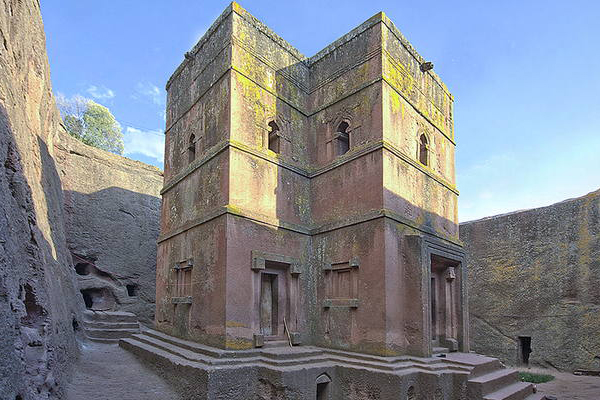 Ever since the first European to describe the rock churches if Lalibela, Francisco Alvarez, came to this holy city between 1521 and 1525, travelers have tried to put into words their experiences. Praising it as a “New Jerusalem” a “New Golgotha”, the “Christian Citadel in the Mountains of Wondrous Ethiopia” . The inhabitants of the monastic township of Roha-Lalibela in Lasta, province of Wollo, dwelling in two storeyed circular huts with dry stonewalls, are unable to believe that the rock churches are entirely made by man. They ascribe their creation to one of the last kings of the Zagwe dynasty, Lalibela, who reigned about 1200 A.D.
Ever since the first European to describe the rock churches if Lalibela, Francisco Alvarez, came to this holy city between 1521 and 1525, travelers have tried to put into words their experiences. Praising it as a “New Jerusalem” a “New Golgotha”, the “Christian Citadel in the Mountains of Wondrous Ethiopia” . The inhabitants of the monastic township of Roha-Lalibela in Lasta, province of Wollo, dwelling in two storeyed circular huts with dry stonewalls, are unable to believe that the rock churches are entirely made by man. They ascribe their creation to one of the last kings of the Zagwe dynasty, Lalibela, who reigned about 1200 A.D.
According to legend before the throne of Ethiopia was restored to its rightful rulers, upon command of God and with the help of Angels, Lalibela’s pious zeal converted the royal residence of the Zagwe in the town of Roha in to a prayer of stone.
In Laliabela itself you will find two main groups of churches, one on each side of the river Jordan and one other church set apart from the rest. The town of Roha-Lalibela lies between the first and the second group of churches. It is situated on the higher part of a mountain-terrace on a vast plateau of rock. At Timkat (Ethiopian Epiphany. Ca. January 19) a vivid ritual unfolds before the spectator: here the dances of the priests take place after the annual repetition of mass baptism in the river Jordan.
There are twelve churches and chapels, including various shrines. Four churches are monolithic in the strict sense; the remainder is excavated churches in different degrees of separation from the rock. The walls of the trenches and courtyards contain cavities and chambers sometimes filled with the mummies of pious monks and pilgrims.
There are three basic types of rock churches in Ethiopia:-
1. Built-up cave churches, which are ordinary structures inside a natural cave (Makina Medhane Alem and Yemrehanna Krestos near Lalibela are examples of this style).
2. Rock-hewn cave churches, which are cut inwards from a more or less vertical cliff face sometimes using and widening an existing natural cave (Abba Libanos in Lalibela).
3. Rock-hewn monolithic churches, which imitate a built-up structure but are cut in one piece from the rock and separated from it all round by a trench. Most churches of this type are found in or near Lalibela (Bet Medhane Alem. Bet Maryam. Bet Giorgis, and others). Nowhere else in the world are constructions of this particular kind found.
Gondar is 50 kilometers north of Lake Tana, 500 Kilometers north of Addis Ababa and nestles in the foothills of the Simien mountains at 2,200 meters above sea level. Gondor was the capital of Ethiopia from the rise of Fasilades to the fall of Tewodros (1855 – 68) which is reflected in the many castles and palaces in the city.
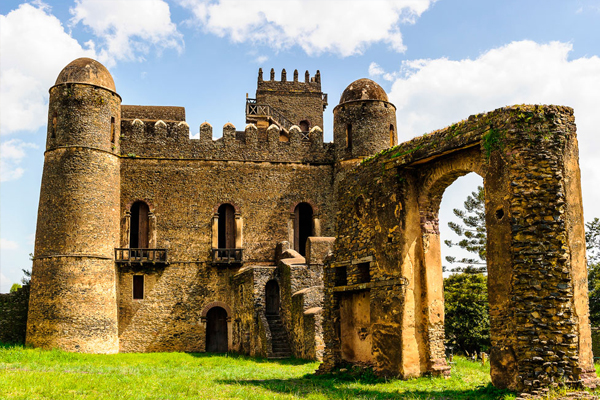 The city’s main imperial precinct, known as the Royal Enclosure, covers an area of 7.7 hectares and contains five castles, raised walkways and connecting tunnels surrounded by high stone walls.
The city’s main imperial precinct, known as the Royal Enclosure, covers an area of 7.7 hectares and contains five castles, raised walkways and connecting tunnels surrounded by high stone walls.
The oldest of these is the Castle of Fasildes. Built of stone in the mid-17th century it reflects a number of influences, Axumite, Portuguese and Indian. The upper storey offers panoramic views and Lake Tana is Visible on a clear day.The castle has been renovated recently.
Fasilades grandson,Iyasu- the great, built his own castle and decorated it with Ivory,gold and precious stones but an earthquake in the early 19th caused sever damage.
The palace of Ras Beit, was built in the 18th century as a private residence of the famous king maker, Ras Mikael Sehul and has been in continues occupation ever since.
Bath of Fasilades is a sunken pool still used for the Timkat Festival in January.
One of the most spectacular art painted churches in Ethiopia Debre Birhan Selassie can be seen here.
Ethiopia’s historic route begins with a glance at the tantalizing remains of Yeha-the country’s earliest high civilization.
In a remote part of Tigray region, Yeha lies several hours drive from the more accessible city of Axum, the journey takes you on rough tracks through dramatic highland scenery and eventually ends in a beautiful and serene agricultural hamlet. It is there, close to a much more recent Christian church, that you my see the towering ruins of Yeha’s Temple of the Moon-built more than 2,500 years ago, in Sabaean times.
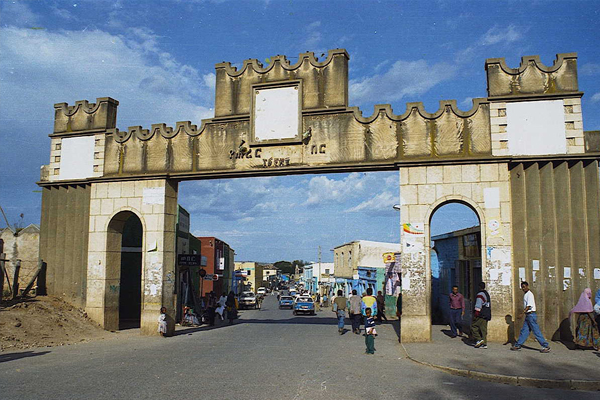 Harar is a walled city which stands on the eastern wall of the Great Rift Valley and is the provincial capital of Ethiopia’s largest administrative region, Hararge. The city’s location gives wonderful views of the surrounding country-the vast Danakil desert to the north, the fertile Harar Mountains to the west, and the cattle rich Ogaden plains to the south.
Harar is a walled city which stands on the eastern wall of the Great Rift Valley and is the provincial capital of Ethiopia’s largest administrative region, Hararge. The city’s location gives wonderful views of the surrounding country-the vast Danakil desert to the north, the fertile Harar Mountains to the west, and the cattle rich Ogaden plains to the south.
Harar was a fiercely religious city and was a forbidden city (closed to visitors), until 1887 when Menelik restored central rule. With its 99 mosques, including the 16th century Grand Mosque with is beautiful twin towers and slender minaret, it is considered to be the fourth most holy city in Islam after Mecca, Medina and the Dome of the Rock in Jerusalem.
Medhane Alem church, built at the end of the 19th century, is in the town centre and contains excellent examples of traditional regional art.
The community Museum, also in the town centre, has displays relating to the way of life in earlier times.
The 16th century Grand Mosque, with is beautiful twin towers and slender minaret lies on the road to the Erer Gate women are not permitted inside the mosque.
The vibrant market place is regarded as one of the most colorful in all Ethiopia.
Off the road from the Sauga Gate to the main market lies Ras Mekonen’s house where Haile Selassie spent most of his childhood.
The house of the famous French poet Arthur Rambus is unique in its architectural design.
The Ahmar Mountains around Harar produce some of the best coffee in Ethiopia.
The Hyena Men of Harar collect offal and bones to feed to the wild hyenas usually about 100 meters outside the Fallana Gate of the old city walls of the town. Hyenas appear just after sunset to take food from their hands.